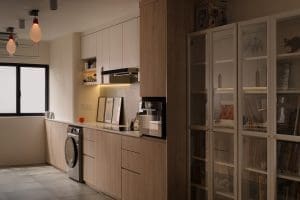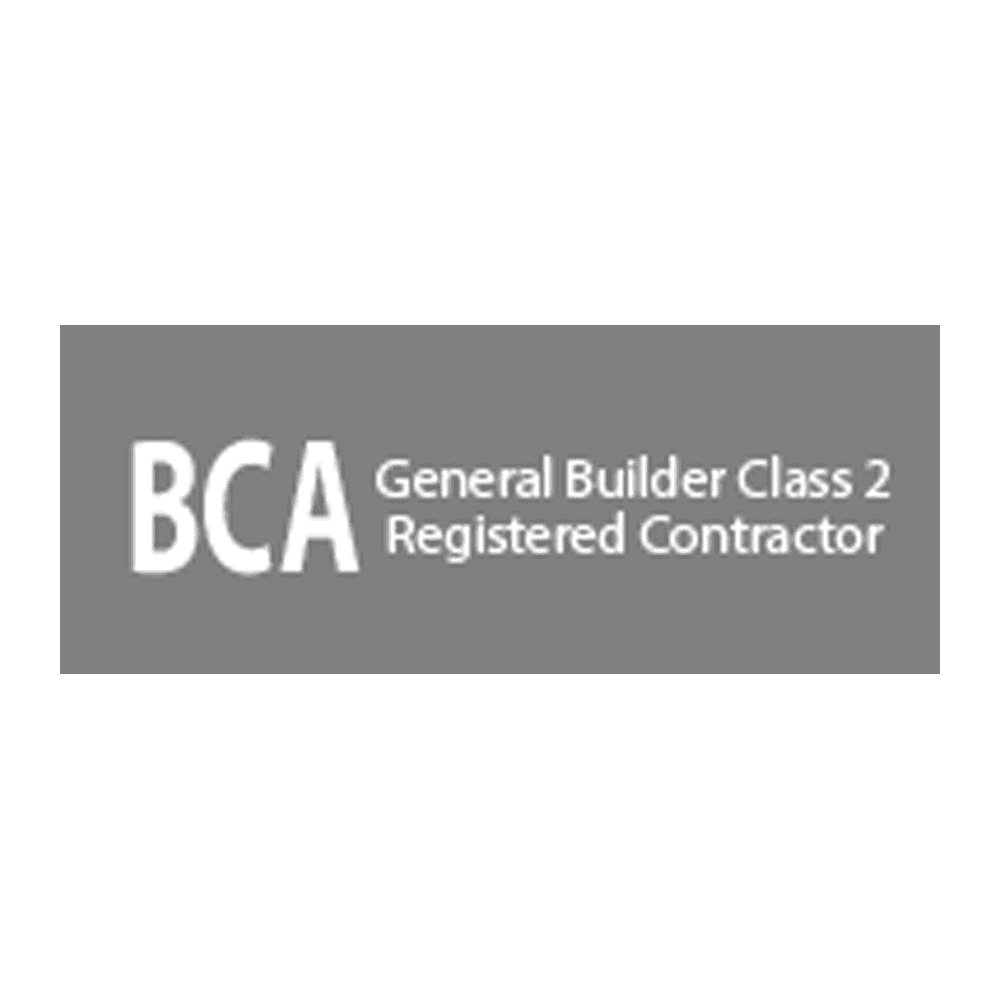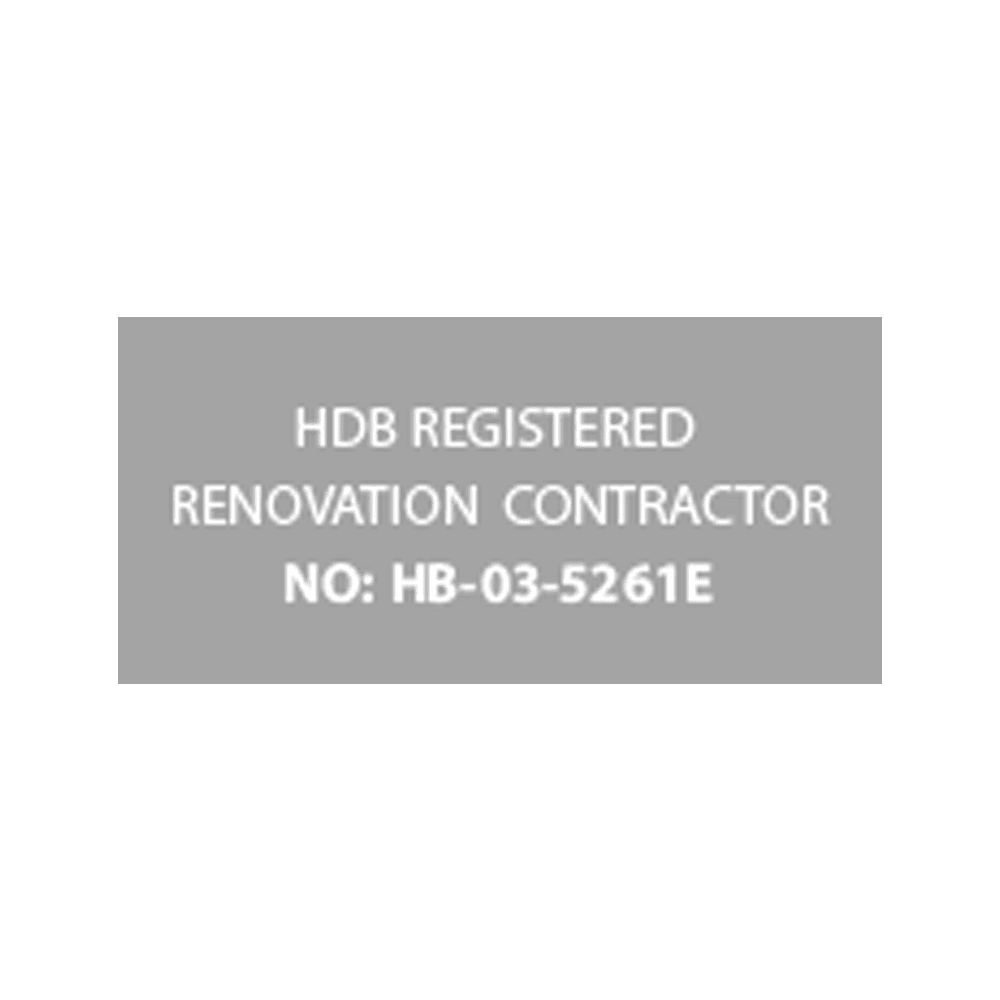Renovating Your Landed Property in Singapore: Is It Worth the Cost?
February 20, 2023
As a landed property owner in Singapore, you may be considering renovating your home to improve its functionality, comfort, and aesthetics. However, you may also be wondering whether it’s worth the cost. In this article, we’ll explore the factors that affect renovation costs, tips for minimizing expenses, and the average costs of common renovation projects in Singapore.
As you can see, the requirements for a detached bungalow are more relaxed than those for a good class bungalow (GCB), which has stricter requirements due to its larger size and more exclusive location. If you own a semi-detached or corner terrace 1 property, there are no setback or site coverage controls, but you still need to adhere to setback controls for the front, side, and rear of your property and it can affect your terrace house renovation cost.
Terrace 1 intermediate and corner terrace 2 properties have fixed setback controls for the front and more relaxed controls for the side and rear. These requirements can impact the layout and design of your home, so it’s essential to work with an experienced architect or interior designer who understands these limitations and can work within them to create a functional and aesthetically pleasing home.

Keep in mind that these are average costs, and your actual expenses may vary depending on the size and complexity of your project, the materials you choose, and other factors.
To give you an idea of the costs involved, here is a table outlining the estimated renovation costs for various types of landed properties in Singapore:
Of course, these are just rough estimates, and the actual cost of your renovation project will depend on a number of factors, including the size of your property, the scope of the work, and the materials and finishes that you choose. However, this table should give you a general idea of what to expect when it comes to renovating your landed property in Singapore.
 Uncategorized
Uncategorized
Minimum plot size and setback requirements for different types of properties in Singapore
First, let’s take a look at the minimum plot size and setback requirements for different types of properties in Singapore. These requirements vary depending on the type of property, and they can significantly affect the design and construction of your home. Here’s a table that lists the minimum plot size, minimum width and depth, site coverage, setback control, and boundary clearance for roof eaves for different types of properties:| Type | Minimum plot size (m2) | Minimum width (m) | Minimum depth (m) | Site coverage | Setback control (m) | Boundary clearance for roof eaves (m) |
| Detached (bungalow) | 400 | 10 | No control | 50% | Front: 7.5 | Front patio: 2.4, Car porch: 2.4, Side/rear: 1 |
| Good class bungalow (GCB) | 1,400 | 18.5 | 30 | 40% | Front: 7.5 | Front patio: 5.1, Car porch: 2.4, Side/rear: 1.6 |
| Semi-detached and corner terrace 1 | 200 | 8 | No control | No control | Front: 7.5 | Front patio: 2.4, Car porch: 2.4, Side/rear: 1 |
| Terrace 1 intermediate | 150 | 6 | No control | No control | Front: 7.5, Rear: 2 | Front patio: 2.4, Car porch: 2.4, Rear: 1 |
| Terrace 2 intermediate | 80 | 6 | No control | No control | Front: 1 (fixed), Rear: 2 | Front: nil, Rear: 1 |
| Corner terrace 2 | 80 | 8 | No control | No control | Front: 1 (fixed), Side: 2, Rear: 2 | Front: nil, Side/rear: 1 |
Benefits of renovating a landed property in Singapore
Renovations can significantly improve your quality of life by creating a more comfortable and functional home. For example, upgrading your kitchen can make cooking and entertaining more enjoyable, while renovating your bathroom can make your daily routine more pleasant. Renovations can also increase the value of your property, which can be especially beneficial if you plan to sell in the future. Additionally, renovations can enhance the aesthetics and style of your home, making it a more pleasant and welcoming space to live in.Factors that affect renovation costs for landed properties in Singapore
Of course, renovation costs can be a concern for many homeowners, especially if you’re on a tight budget. Here are they:- Size and complexity of the project: The larger and more complex the project, the more expensive it will be. This is because it will require more time, labor, and materials to complete.
- Materials and finishes: The cost of materials and finishes can vary widely, depending on their quality and brand. For example, marble flooring will be more expensive than vinyl flooring.
- Contractor fees: The fees charged by your contractor can also impact the overall cost of your renovation. Some contractors may charge higher fees for more complex projects, while others may offer discounts for larger projects.
- Structural changes: If your renovation requires structural changes, such as removing walls or adding new windows, it will likely be more expensive than a project that only involves cosmetic changes.
- Permits and approvals: Depending on the scope of your renovation, you may need to obtain permits and approvals from the relevant authorities. These can add additional costs to your project.
- Age and condition of the property: If your property is older or in poor condition, it may require more extensive renovations to bring it up to modern standards. This can also impact the overall cost of your renovation.

Tips for minimizing renovation costs
If you’re planning a renovation for your landed property in Singapore, you may be concerned about the cost. However, there are several ways to minimize expenses and stay within your budget. Here are some tips:- Set a budget: Plan ahead and set a budget for your renovation. This can help you prioritize your expenses and avoid overspending.
- Plan strategically: Strategically plan your renovation to avoid unnecessary costs. Consider what areas of your property need the most attention and focus on those first.
- Research materials and finishes: Do your research on materials and finishes before making a purchase. Look for options that are high-quality but still affordable.
- Choose a reliable contractor: Hiring a reliable contractor can save you money in the long run. A good contractor can help you avoid costly mistakes and ensure that the renovation is completed on time and within budget. Choose one that can give your various landed renovation packages.
- Consider DIY options: Consider taking on some projects yourself to save money. However, be realistic about your skills and limitations and avoid taking on projects that are beyond your abilities.
- Reuse or repurpose existing materials: Look for opportunities to reuse or repurpose existing materials in your renovation. For example, you could refinish existing cabinets instead of buying new ones.
- Don’t overdo it: Avoid overdoing it with unnecessary upgrades and features. Stick to what is practical and essential for your property.
Average renovation costs for landed properties in Singapore
When it comes to selecting renovation projects, it’s important to focus on those that add the most value to your property. Some examples of high-value renovations include kitchen and bathroom upgrades, which can significantly increase your home’s resale value. Flooring renovations and painting and wall finishing are also popular projects that can improve the aesthetics of your home without breaking the bank. Lighting and electrical upgrades can also improve the functionality and safety of your home. So, how much can you expect to pay for common renovation projects in Singapore? Here’s a breakdown of average renovation costs for different projects:| Renovation Task | Estimated Cost (SGD) |
| Carpentry Works | 15,000 – 40,000 |
| Electrical Works | 2,000 – 5,000 |
| Plumbing Works | 2,000 – 5,000 |
| Painting Works | 2,000 – 6,000 |
| Flooring Works | 4,000 – 10,000 |
| Ceiling Works | 3,000 – 8,000 |
| Air-Conditioning Installation | 3,000 – several options are available |
| Lighting Fixtures | 1,000 – 3,000 |
| Window and Grilles Installation | 3,000 – 6,000 |
| Kitchen Renovation | 8,000 – 25,000 |
| Bathroom Renovation | 8,000 – 15,000 |
| Overall Renovation (Full Package) | 60,000 – 150,000 |
| Type of Property | Estimated Renovation Cost (SGD) |
| Detached (Bungalow) | 500,000 – 1,500,000 |
| Good Class Bungalow (GCB) | 1,500,000 – 5,000,000 |
| Semi-Detached | 200,000 – 500,000 |
| Corner Terrace | 250,000 – 700,000 |
| Intermediate Terrace | 150,000 – 350,000 |

Renovation financing options for landed property owners in Singapore
Renovating a landed property in Singapore can be a costly endeavor, and not everyone has the financial means to pay for it upfront. Fortunately, there are several financing options available to homeowners who want to renovate their properties. These include:- Home renovation loans: These are loans specifically designed for home renovation purposes, with repayment periods ranging from one to five years.
- Refinancing existing mortgages: This option involves refinancing an existing mortgage and borrowing additional funds to cover the renovation costs. The repayment period for the refinanced mortgage can be extended up to 30 years.
- Personal loans: Personal loans can be used to cover renovation costs, but they typically come with higher interest rates compared to home renovation loans and refinancing options.
Implications of minimum plot size and setback requirements
The minimum plot size and setback requirements for landed properties in Singapore can have significant implications on the design and construction of homes. Homeowners must take these requirements into consideration when planning their renovations to avoid potential legal and financial issues. Some tips for working within the limitations of these requirements include:- Consulting with a professional architect or interior designer who is familiar with the regulations and can help design a home that meets the requirements while still being functional and aesthetically pleasing.
- Being aware of the zoning regulations in the area where the property is located, as they can impact the allowable land use, building height, and other aspects of the renovation.
- Obtaining the necessary permits and approvals from the authorities before starting any construction work to avoid potential fines or legal issues.
Are you ready to turn your Singaporean landed property into your dream home? Ovon-D can make it happen!
With hassle-free E-WARRANTY, Ovon-D offers an easy and hassle-free E-WARRANTY program to give you the confidence you need to make that final investment decision for your Singapore landed property renovation. It is because we are a company whose mission is to provide excellence and quality service for OUR BELOVED customers worldwide, as well as being a reliable, honest, professional, and trustworthy company. Click here to learn more about our service or visit our showroom at 53 Joo Chiat Place Singapore 427777 or 534 Balestier Road Singapore 329860.
Ovonites
Home renovations are an important aspect of homeownership in Singapore, as they can add value to your property and make your living spaces more comfortable and functional. However, financing a renovation project can be a challenge, as it often requires a significant amount of money. This is where loan options come into play. In Singapore, various loan options are available to finance your home renovation, each with its own set of pros and cons. In this article, we will comprehensively analyze the different loan options available for home renovations in Singapore, and help you determine which option is best for you.
Here is a table of comparison for some of the popular banks in Singapore that offer home renovation loans:

There are various loan options available for home renovations in Singapore, each with its own set of pros and cons. When choosing a loan option, it’s important to consider your financial situation, the amount of money you need, and the repayment terms that are most suitable for you. By comparing the different loan options and their features, you can confidently determine which option is best for you and finance your renovation project.

What is Home Renovation Loan in Singapore?
A home renovation loan in Singapore is a type of financing offered by banks, financial institutions, and other lending organizations to help homeowners pay for renovations to their properties. These loans often come with flexible repayment periods, low interest rates, and easy application processes. They can be used to cover the cost of materials, labor, and other expenses associated with home upgrades.What Type of Renovations Covered by Home Renovation Loan?
A home renovation loan can be used to cover a variety of renovation projects, including but not limited to:- Kitchen upgrades – Installing new countertops, cabinets, and appliances
- Bathroom renovations – Updating fixtures, adding a new bathtub or shower, and installing new flooring
- Living space upgrades – Installing new flooring, painting, and updating lighting fixtures
- Outdoor renovations – Adding a deck, patio, or landscaping to your outdoor living space
- Room additions – Adding an extra room or expanding an existing room
- Energy-efficient upgrades – Installing new windows, insulation, and heating/cooling systems
- Structural upgrades – Adding support beams, reinforcing walls, or making other changes to the structure of your home.
Bank Loans for Home Renvoation
Bank loans are one of the most popular loan options for home renovations in Singapore. DBS Bank, OCBC Bank, and UOB Bank are some of the most reputable lenders in the market that offer home renovation loans. Here are some of the pros and cons of bank loans for home renovations:Pros:
- Widely available: Bank loans are widely available and can be easily obtained from any of the popular banks in Singapore for HDB renovation loan.
- Low-interest rates: Bank loans typically come with lower interest rates compared to other loan options, making them a cost-effective solution for financing your home renovation.
- Reputable lenders: Banks are well-established and reputable lenders, which can provide peace of mind when it comes to the security of your loan.
Cons:
- Strict eligibility requirements: Banks have strict eligibility requirements, and you may not be approved for a loan if you don’t meet their criteria.
- Long application process: The application process for bank loans can be time-consuming, as it often involves multiple rounds of documentation and paperwork.
- High repayment period: Bank loans typically have a high repayment period, which can last several years.
| Bank Name | Interest Rate | Repayment Period | Eligibility Requirements |
| DBS Renovation Loan | 2.68% | 7 years | Minimum Age 21 |
| OCBC Renovation Loan | 2.80% | 7 years | Minimum Age 21 |
| UOB Renovation Loan | 2.78% | 7 years | Minimum Age 21 |
Personal Loans for Home Renovation
Personal loans are another loan option for home renovations in Singapore. They are often quicker and easier to obtain compared to bank loans, and come with more flexible repayment terms. Here are some of the pros and cons of personal loans for home renovations:Pros:
- Quick and easy application process: Personal loans typically have a quick and easy application process, with many online lenders offering instant approval.
- Flexible repayment terms: Personal loans come with flexible repayment terms, allowing you to choose a repayment period that suits your financial situation.
- No collateral required: Unlike bank loans and home equity loans, personal loans do not require any collateral, making them a more accessible option for those without any property.
Cons:
- Higher interest rates: Personal loans typically come with higher interest rates compared to bank loans, making them a more expensive option for financing your home renovation.
- Limited loan amount: Personal loans often come with limited loan amounts, which may not be enough to cover the entire cost of your renovation project.
- Short repayment period: Personal loans typically have a short repayment period, which can be challenging for those with limited financial resources.
| Bank Name | Interest Rate | Repayment Period | Eligibility Requirements |
| Maybank renovation loan | 4.18% | 3 years | Minimum Age 21 |
| CitiBank | 4.50% | 5 years | Minimum Age 21 |
| Standard Chartered Bank | 4.25% | 5 years | Minimum Age 21 |

Home Equity Loans for Renovation
Home equity loans are another loan option for home renovations in Singapore. They are secured loans that use your property as collateral, and can provide a larger loan amount compared to personal loans. Here are some of the pros and cons of home equity loans for home renovations:Pros:
- Large loan amount: Home equity loans can provide a larger loan amount compared to personal loans, which can be useful for financing larger renovation projects.
- Lower interest rates: Home equity loans typically come with lower interest rates compared to personal loans, making them a more cost-effective option for financing your home renovation.
- Secured loan: Home equity loans are secured loans, which can provide peace of mind when it comes to the security of your loan.
Cons:
- Long repayment period: Home equity loans typically have a long repayment period, which can last for several years.
- Risk of losing your property: Home equity loans use your property as collateral, which means you risk losing your property if you are unable to repay the loan.
- Strict eligibility requirements: Home equity loans have strict eligibility requirements, and you may not be approved for a loan if you don’t meet their criteria.
| Lender Name | Interest Rate | Repayment Period | Eligibility Requirements |
| POSB Bank | 3.18% | 10 years | Minimum Age 21 |
| HSBC Bank | 3.50% | 10 years | Minimum Age 21 |
| CIMB Bank | 3.25% | 10 years | Minimum Age 21 |

Let Ovon-D Ease Your Renovation Process Easily and Beautifully!
Hassle-free E-WARRANTY, Ovon-D offers an easy and hassle-free E-WARRANTY program to give you the confidence you need to make that final investment decision. It is because we are a company whose mission is to provide excellence and quality service for OUR BELOVED customers worldwide, as well as being a reliable, honest, professional, and trustworthy company. Click here to learn more about our service or visit our showroom at 53 Joo Chiat Place Singapore 427777 or 534 Balestier Road Singapore 329860.Ovonites
Green is a color that represents growth, renewal, and freshness. Incorporating green into your home interior can have a positive impact on your mental and emotional well-being. It can create a calming and energizing atmosphere, making your home feel like a peaceful oasis. In this article, we’ll explore the top 10 green color schemes for a fresh and energizing home interior in Singapore.



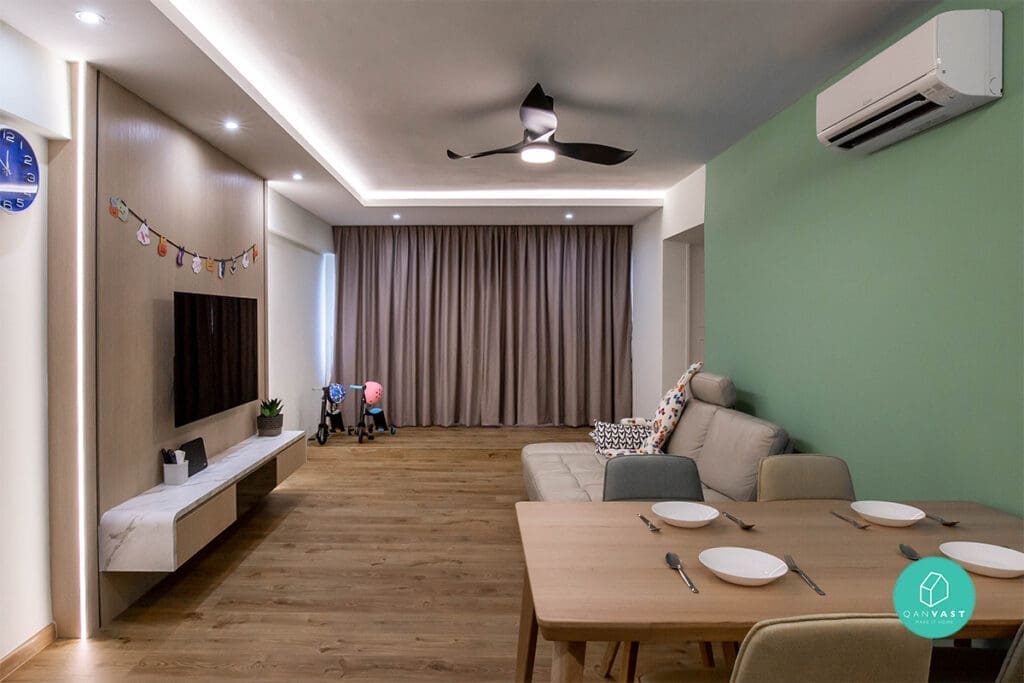
Green Color Scheme #1: Sage Green
Sage green is a soft, muted green color that is both calming and elegant. This color works well in bedrooms and bathrooms, where you want to create a relaxing and serene environment. You can incorporate sage green by painting your walls this color or using sage green accents, such as bed linens, towels, or curtains. One example is to pair sage green walls with white furniture and decor for a fresh, modern look.Green Color Scheme #2: Olive Green
Olive green is a versatile color that works well in a variety of spaces, including living rooms, kitchens, and bedrooms. This rich, earthy color can add warmth and depth to your home interior. You can incorporate olive green by painting your walls or using olive green accents, such as throw pillows, curtains, or rugs. For example, pair olive green walls with natural wood furniture and metallic accents for a stylish and sophisticated look.Green Color Scheme #3: Mint Green
Mint green is a light and fresh green color that is perfect for creating a cheerful and bright atmosphere in your home. This color works well in kitchens, bathrooms, and bedrooms. You can incorporate mint green by painting your walls or using mint green accents, such as curtains, towels, or bed linens. For example, pair mint green walls with white cabinetry and stainless steel appliances for a crisp and clean look.
Green Color Scheme #4: Kelly Green
Kelly green is a bright and bold green color that can add energy and liveliness to your home interior. This color works well in living rooms, kitchens, and home offices. You can incorporate kelly green by painting your walls or using kelly green accents, such as throw pillows, curtains, or area rugs. For example, pair kelly green walls with natural wood furniture and black accents for a modern and eclectic look.Green Color Scheme #5: Hunter Green
Hunter green is a rich and luxurious green color that is perfect for creating a warm and inviting atmosphere in your home. This color works well in living rooms, bedrooms, and home offices. You can incorporate hunter green by painting your walls or using hunter green accents, such as curtains, throw pillows, or rugs. For example, pair hunter green walls with leather furniture and brass accents for a classic and elegant look.Green Color Scheme #6: Seafoam Green
Seafoam green is a light and soft green color that can add a touch of tranquility to your home interior. This color works well in bedrooms, bathrooms, and home offices. You can incorporate seafoam green by painting your walls or using seafoam green accents, such as bed linens, curtains, or towels. For example, pair seafoam green walls with white furniture and natural wood accents for a calming and serene look.Green Color Scheme #7: Forest Green
Forest green is a deep and rich green color that can add a sense of nature and serenity to your home interior. This color works well in living rooms, bedrooms, and home offices. You can incorporate forest green by painting your walls or using forest green accents, such as curtains, throw pillows, or rugs. For example, pair forest green walls with natural wood furniture and white accents for a rustic and cozy look.Green Color Scheme #8: Lime Green
Lime green is a bright and cheerful green color that can add a pop of energy to your home interior. This color works well in kitchens, bathrooms, and home offices. You can incorporate lime green by painting your walls or using lime green accents, such as curtains, towels, or throw pillows. For example, pair lime green walls with black and white accents for a modern and playful look.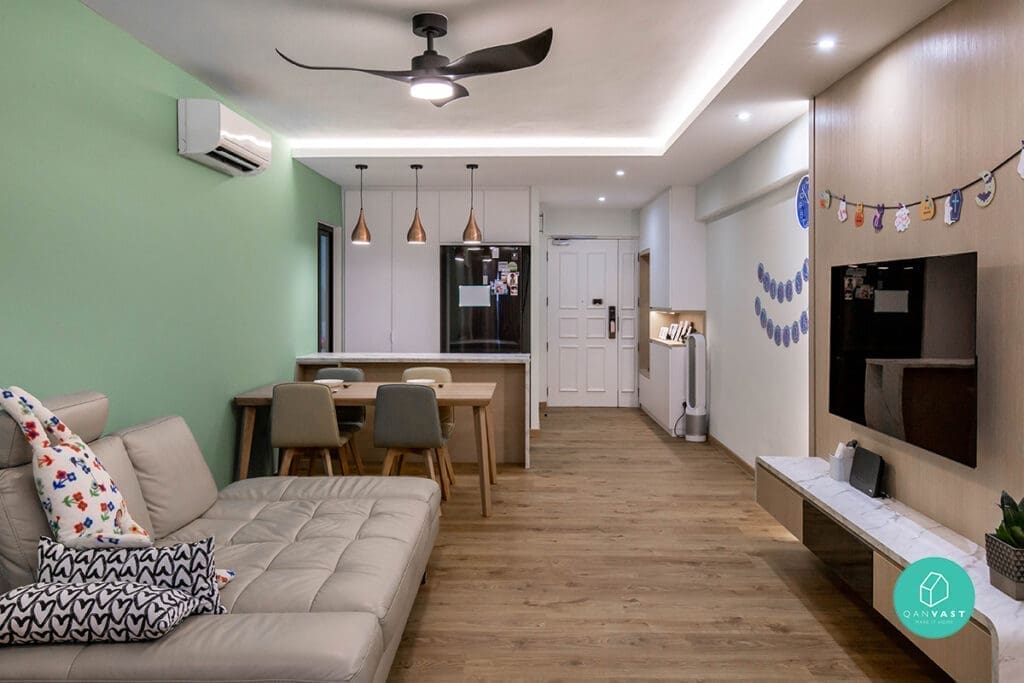
Green Color Scheme #9: Chartreuse Green
Chartreuse green is a unique and eye-catching green color that can add a touch of glamour to your home interior. This color works well in living rooms, bedrooms, and dining rooms. You can incorporate chartreuse green by painting your walls or using chartreuse green accents, such as curtains, throw pillows, or upholstery. For example, pair chartreuse green walls with gold accents for a luxurious and elegant look.Green Color Scheme #10: Emerald Green
Emerald green is a rich and sophisticated green color that can add a touch of elegance to your home interior. This color works well in living rooms, bedrooms, and dining rooms. You can incorporate emerald green by painting your walls or using emerald green accents, such as curtains, throw pillows, or upholstery. For example, pair emerald green walls with neutral accents, such as beige and gray, for a chic and refined look.Green Color and Blue Combination #11: How to:
As an interior designer, combining green and blue can create a fresh and calming interior design scheme. One idea for this color combination is to create a coastal-inspired living room. Here’s how:- Paint your walls in a light blue shade to create a calming and serene atmosphere.
- Add pops of green with a lush fern or a collection of green plants in wicker baskets. This will bring a touch of nature into your space and enhance the calming effect of the blue walls.
- Choose blue and green furniture pieces that complement each other, such as a blue velvet sofa with green accent pillows or a green armchair with a blue and white striped cushion.
- Accessorize your space with a mix of blue and green textiles, such as throw blankets and curtains. Look for patterns that incorporate both colors, such as a blue and green plaid or a blue and green floral print.
- Complete the look with natural wood accents, such as a coffee table made from reclaimed wood or a rustic wood shelf. This will help anchor the space and create a cohesive look.
Whats the Benefits of Having A Green Color Scheme for Interior Design?
A green color scheme in your home interior can have many physical and emotional benefits. Some of these benefits include:- Enhancing mental well-being: Green is known to be a calming and soothing color, which can help reduce stress and promote relaxation. This can have a positive impact on your mental health and well-being.
- Improving air quality: Green plants and foliage can help improve air quality by removing harmful pollutants from the air. This can help create a healthier living environment.
- Boosting creativity: Green is believed to enhance creativity and inspire new ideas, making it a great choice for home offices and creative spaces.
- Encouraging physical activity: Green is associated with nature, which can inspire outdoor activities and physical exercise. This can be especially beneficial in urban environments where green spaces are limited.
- Increasing focus and concentration: Green is known to improve focus and concentration, making it a great color choice for home offices, bedrooms, and other spaces where you need to stay focused.
- Promoting growth and renewal: Green is associated with growth and renewal, making it a great color choice for homes undergoing renovation or change.
- Creating a natural and harmonious environment: Green is a natural and harmonious color, which can help create a peaceful and calming atmosphere in your home.
Transform your home into a peaceful and rejuvenating sanctuary with 9Creation
Our team of experienced designers can help you incorporate the perfect green color scheme into your home to enhance your mental well-being, boost your creativity, and promote growth and renewal. Don’t wait, contact 9Creation Singapore today to schedule a consultation and bring your green interior design vision to life. A professional interior design service, such as 9Creation, can make your home listing one of the best investments you make in getting more buyers into your home. By creating an interior design and a 3D representation of your home, you’ll get the best visualization of your long-last investment before making the most significant decision. Get yours with 9Creation here to prevent unwanted results that will waste your money and time. Visit our showroom at East: 140 Paya Lebar Road #01-14, AZ @ Paya Lebar S(409015) or West: 18 Boon Lay Way #01-98A Tradehub 21 S(609966).Ovonites
Breaking Down the Top 5 of Most Popular Interior Design: Which One Best Suits Your Personality?
February 13, 2023
Are you tired of coming home to a space that doesn’t reflect your unique personality and style? The interior design of your home can have a significant impact on your mood, productivity, and overall well-being. Choosing the right design style can make your living space feel more inviting, comfortable, and personalized. But with so many different design styles to choose from, how do you know which one is the best fit for you?
In this article, we will break down the many styles of interior design and explore how your personality can play a role in finding the perfect design for your home. Get ready to discover the design style that will best reflect your individuality and create a space that truly feels like home.



Minimalist Interior Design
Minimalist interior design is all about simplicity, functionality, and space. Here are some of the key characteristics of minimalist design:- Clean lines and simple shapes: Minimalist design favors simple geometric shapes and clean, straight lines.
- Neutral color palette: Minimalist design tends to use a neutral color palette, with shades of white, black, and gray being the most common.
- Clutter-free space: Minimalist design values open space and avoids clutter. Furniture and decor items are kept to a minimum.
- Focus on functionality: Minimalist design prioritizes function over form, with practicality and usability taking precedence over ornamentation.
- A sleek and simple platform bed with minimal bedding
- A single statement piece of art on an otherwise empty wall
- A simple, unadorned dining table with just a few chairs
- A minimalist pendant light fixture with clean lines and neutral tones
- A clutter-free workspace with just a few essential items on the desk
Industrial Interior Design
Industrial interior design is all about blending raw, unfinished materials with sleek, modern elements. Here are some of the key characteristics of industrial design:- Exposed materials: Industrial design features raw, unfinished materials such as brick, concrete, and metal. These materials are often left exposed rather than covered up with traditional finishes.
- Neutral color palette: Similar to minimalist design, industrial design favors a neutral color palette with shades of gray, black, and white being the most common.
- Reclaimed and vintage items: Industrial design often incorporates reclaimed and vintage items such as old factory lamps, metal lockers, and vintage signs.
- Open floor plans: Industrial design values open space and often features open floor plans with minimal walls or partitions.
- An exposed brick wall or concrete flooring
- A reclaimed wood coffee table or shelving unit
- An industrial pendant light fixture with metal shades and exposed bulbs
- A vintage metal locker for storing items
- An open floor plan with exposed ductwork and piping
Bohemian Interior Design
Bohemian interior design is all about embracing creativity, comfort, and a free-spirited aesthetic. Here are some of the key characteristics of bohemian design:- Bold patterns and textures: Bohemian design incorporates a variety of bold patterns and textures, including Moroccan textiles, woven wall hangings, and vibrant printed fabrics.
- Eclectic decor: Bohemian design is all about mixing and matching different styles, eras, and cultures. This can include anything from vintage furniture to global-inspired decor.
- Natural elements: Bohemian design values natural materials such as wood, rattan, and woven materials. It also often includes plants and greenery to bring a sense of nature into the space.
- Colorful accents: Bohemian design incorporates a variety of colors, with an emphasis on rich jewel tones and warm earthy hues.
- A Moroccan-inspired rug or tapestry
- A mix of vintage and global-inspired decor
- A woven rattan chair or basket
- An eclectic gallery wall featuring artwork and textiles
- A variety of plants and greenery throughout the space
Scandinavian Interior Design
Scandinavian interior design is characterized by simplicity, functionality, and a focus on natural materials. Here are some of the key characteristics of Scandinavian design:- Clean lines: Scandinavian design features clean, simple lines and a minimalistic approach to decor. Furniture and decor items are often functional and streamlined.
- Light colors: Scandinavian design uses a neutral color palette of whites, grays, and natural wood tones to create a bright, airy atmosphere.
- Natural materials: Scandinavian design values natural materials such as wood, leather, and wool. These materials are often left in their natural state, with a focus on the texture and grain.
- Cozy accents: While Scandinavian design is minimalistic, it also includes cozy accents such as faux fur throws, knitted textiles, and plush rugs.
- A wooden coffee table or bookshelf
- A white or neutral-toned sofa with clean lines
- A cozy knit throw or faux fur pillow
- A natural fiber rug
- Minimalistic, functional lighting fixtures
Traditional Interior Design
Traditional interior design is a classic style that is characterized by elegance, symmetry, and attention to detail. Here are some of the key characteristics of traditional design:- Rich colors and patterns: Traditional design features a rich color palette with deep jewel tones and intricate patterns. Wallpapers, draperies, and upholstery often feature patterns such as florals, damasks, and stripes.
- Classic furniture: Traditional design incorporates classic, elegant furniture pieces such as wingback chairs, rolled-arm sofas, and clawfoot tables. These pieces are often made from rich, high-quality materials such as mahogany or cherry wood.
- Symmetry: Traditional design places a strong emphasis on balance and symmetry. Furniture and decor items are often arranged in a symmetrical fashion, and the room layout is often centered around a focal point such as a fireplace or large window.
- Ornate details: Traditional design features intricate details such as molding, trim, and carvings. These details add visual interest and depth to the space.
- A classic chandelier or wall sconce
- Upholstered furniture in rich colors and patterns
- A Persian or Oriental rug
- Crown molding for wainscoting
- Classic artwork or portraits

In conclusion
As you reach the end of this article, we hope that you now have a better understanding of the different styles of interior design and how they align with specific personality traits. It’s important to remember that there’s no one-size-fits-all approach to design, and what works for one person may not work for another. We encourage you to explore and experiment with different design styles to find the best fit for your personality and lifestyle. With the right design elements, you can create a comfortable and inviting living space that truly reflects who you are. Remember, the key is to make your space uniquely your own, and to have fun with the design process. So go ahead, and let your personality shine through in your interior design choices!Renovate your house with Ovon-D!
hassle-free E-WARRANTY Ovon-D offers an easy and hassle-free E-WARRANTY program to give you the confidence you need to make that final investment decision. It is because we are a company whose mission is to provide excellence and quality service for OUR BELOVED customers worldwide, as well as being a reliable, honest, professional, and trustworthy company. Click here to learn more about our service or visit our showroom at 53 Joo Chiat Place Singapore 427777 or 534 Balestier Road Singapore 329860.Ovonites
10 Creative Ways to Kitchen Renovation Financing in Singapore
February 10, 2023
Kitchen renovation is an exciting and transformative project for homeowners in Singapore. It can not only improve the kitchen’s functionality but also increase the home’s value. However, funding a kitchen renovation project can be challenging, especially for those unfamiliar with the financing options available. That’s why, in this article, we will explore the different kitchen renovation financing options in Singapore and provide tips for finding the right loan solution for your project.
Note: The interest rates listed above are subject to change and are only a rough estimate. The actual interest rate that you receive may vary based on your credit score, loan amount, repayment period, and other factors. It’s important to compare loan options and interest rates from multiple banks to find the best deal.

Common Kitchen Renovation Financing Options
1) Personal Loans
Personal loans are unsecured loans that can be used for any purpose, including kitchen renovation. This option is quick and easy to obtain, but the interest rates can be higher than other financing options.2) Home Equity Loans
Home equity loans allow homeowners to borrow against the equity in their homes. This option offers lower interest rates and longer repayment terms, but it also puts the homeowner’s home at risk.3) Credit Cards
Credit cards are a convenient option for financing smaller kitchen renovation projects, but the interest rates can be high, and it may not be possible to spread the cost of a larger project over several months.4) Renovation Loans Offered by Banks
Banks in Singapore offer special loans for home renovation projects, which are often called renovation loans. These loans are secured against the property and offer lower interest rates and longer repayment terms than personal loans.5) Kitchen Remodel Loans and Financing Options in Singapore
In addition to the options mentioned above, there is also specific kitchen remodel loans and financing options available in Singapore. These loans are designed specifically for kitchen renovation projects and may offer lower interest rates and longer repayment terms than other financing options.Advantages and Disadvantages of Different Financing Options
1) Personal Loans
Personal loans are unsecured loans that can be used for various purposes, including kitchen renovation projects. They are typically quick and easy to obtain, and the application process is straightforward. However, personal loans tend to have higher interest rates compared to other financing options, and the repayment terms can be shorter. This can result in higher monthly repayments, making it more challenging to budget for the loan. Personal loans may not be suitable for larger kitchen renovation projects, as they typically have lower loan amounts available.2) Home Equity Loans
Home equity loans are secured loans that use the homeowner’s property as collateral. The main advantage of home equity loans is that they typically offer lower interest rates than personal loans and other financing options. Additionally, home equity loans often come with longer repayment terms, making monthly repayments more manageable. However, one significant disadvantage of home equity loans is that the homeowner’s property is at risk if they cannot repay the loan. This can be a significant concern for homeowners who are already struggling with debt.3) Credit Cards
Credit cards are a convenient option for financing smaller kitchen renovation projects, as they are quick and easy to obtain and can be used for purchases at any time. However, credit cards also come with high-interest rates, which can quickly add up if the balance is not paid off in full each month. Credit cards are not typically a good option for larger kitchen renovation projects, as they usually have lower credit limits and may not provide enough funds to cover the project’s cost.4) Renovation Loans
Renovation loans are secured loans designed specifically for home renovation projects, including kitchen renovations. These loans typically offer lower interest rates than personal loans and other financing options, and they also come with longer repayment terms. However, renovation loans may restrict how the loan funds can be used, and the borrower may need to provide detailed plans and specifications for the renovation project. Additionally, renovation loans may require more documentation and paperwork than other financing options.5) Kitchen Remodel Loans
Kitchen remodel loans are similar to renovation loans, but they are specifically designed for kitchen renovation projects. Like renovation loans, kitchen remodel loans offer lower interest rates and longer repayment terms than personal loans and other financing options. However, kitchen remodel loans may also have restrictions on how the loan funds can be used, and the borrower may need to provide detailed plans and specifications for the renovation project. Additionally, kitchen remodel loans may require more documentation and paperwork than other financing options.| Loan Option | Interest Rate | Repayment Period | Eligibility Criteria |
| Personal Loan | 2.5% – 6% p.a. | 1 – 5 years | Minimum annual income of $30,000 |
| Home Equity Loan for kitchen Remodel | 2% – 3% p.a. | 5 – 25 years | Homeowner with equity in property |
| Renovation Loan | 2.5% – 3.5% p.a. | 5 – 15 years | Homeowner with property used as collateral |
| Kitchen Remodel Loan | 2.5% – 3% p.a. | 5 – 15 years | Homeowner with property used as collateral |
How do I get a bank loan in Singapore?
Getting a bank loan in Singapore is a straightforward process that typically involves the following steps:1) Determine your loan amount and repayment period
Before applying for a loan, it’s important to determine how much you need to borrow and over what period of time you plan to repay the loan. This will help you to determine which loan options are suitable for your needs and budget.2) Choose a suitable loan option
There are several loan options available in Singapore, including personal loans, home equity loans, credit cards, renovation loans, and kitchen remodel loans. Each option has its own set of benefits and drawbacks, so it’s important to choose the one that best suits your needs. 3) Compare loan terms and interest rates Once you have selected a loan option, you should compare the loan terms and interest rates offered by different banks in Singapore to ensure that you are getting the best deal. You can use online comparison tools or consult with a loan specialist to help you compare loan options.4) Prepare your documentation
To apply for a loan, you will typically need to provide documentation such as proof of income, identity, and property ownership. It’s important to gather all of the necessary documentation before applying to ensure that the application process goes smoothly.5) Submit your loan application
Once you have all of the necessary documentation, you can submit your loan application to the bank of your choice. The bank will review your application and, if approved, will provide you with the loan funds.6) Repay your loan
You will need to repay your loan according to the terms agreed upon in the loan agreement. This will typically involve making regular payments to the bank until the loan is fully repaid. It’s important to remember that loan terms and interest rates vary greatly from one bank to another, so it’s essential to shop around and compare options before making a decision.Kitchen Remodel Cost Information and Service Options from Different Banks in Singapore
The cost of a kitchen renovation loan in Singapore will vary depending on the lender, the loan amount, and the repayment terms. Here is a comparison of loan options from some of the major banks in Singapore:Tips for Finding the Right Kitchen Renovation Loan
1) Determine the Cost of Your Project
Before applying for a loan, it’s essential to have a clear understanding of the cost of your kitchen renovation project. This will help you determine how much you need to borrow and choose a loan that is suitable for your needs.2) Compare Interest Rates and Repayment Terms
Different banks in Singapore offer different interest rates and repayment terms for kitchen renovation loans. It’s crucial to compare these options to find the loan that offers the best combination of interest rate and repayment terms for your budget.3) Consider the Total Cost of the Loan
When comparing loan options, it’s important to consider the total cost of the loan, including any fees and charges. This will help you find the loan that offers the best value for your money.4) Read the Loan Agreement Carefully
Before signing a loan agreement, it’s essential to read the terms and conditions carefully. Make sure you understand the interest rate, repayment terms, and any restrictions or limitations on how the loan funds can be used.5) Consider Your Ability to Repay the Loan
Before taking out a loan, it’s important to consider your ability to repay the loan. Make sure that you have a stable income and budget to meet the loan repayments over the loan term. Kitchen renovation financing can be challenging, but it can also be a rewarding experience with the right loan solution. By considering the cost of your project, comparing loan options, and choosing a loan that meets your needs, you can confidently finance your kitchen renovation project. With this guide, we hope you can make an informed decision and find the right loan solution for your needs.
Transform your kitchen with Ovon-D interior design!
With hassle-free E-WARRANTY! Ovon-D offers an easy and hassle-free E-WARRANTY program to give you the confidence you need to make that final investment decision. It is because we are a company whose mission is to provide excellent and quality service for OUR BELOVED customers worldwide, as well as being a reliable, honest, professional, and trustworthy company. Click here to learn more about our service or visit our showroom at 53 Joo Chiat Place Singapore 427777 or 534 Balestier Road Singapore 329860.Ovonites
Home renovation is a vital aspect of homeownership in Singapore, as it enhances the comfort, value, and appearance of a property. To make these renovations a reality, homeowners often turn to home renovation loans, which provide the financial support they need to bring their renovation visions to life. In this article, we’ll take a comprehensive look at home renovation loan options in Singapore, comparing the different loan options, and outlining the key factors that homeowners should consider when choosing a loan.



What are the Requirements to Apply for HDB Renovation Loan in Singapore?
To apply for a home renovation loan in Singapore, you will typically need to meet the following requirements:- Eligible Property: The property you want to renovate must be in Singapore and must be either your primary residence or an investment property. Some banks may have additional requirements, such as a minimum property value or a minimum loan amount.
- Proof of Income: You will need to provide proof of your income, such as your payslips or your latest Notice of Assessment (NOA) from the Inland Revenue Authority of Singapore (IRAS). This is to demonstrate that you have the ability to repay the loan.
- Proof of Identity: You will need to provide proof of your identity, such as your NRIC or passport. This is to ensure that you are eligible for the loan and to verify your identity.
- Proof of Ownership: You will need to provide proof of ownership of the property you want to renovate, such as the original Sale and Purchase Agreement or the latest property tax bill. This is to confirm that you have the legal right to renovate the property.
- Renovation Plan and Cost Estimates: You will need to provide a detailed renovation plan, including cost estimates for all materials, labor, and services. This will help the bank determine the loan amount you need and assess your ability to repay the loan.
- Good Credit History: To be eligible for a home renovation loan, you will typically need to have a good credit history, with no overdue payments or defaults on previous loans. The bank will check your credit history as part of the loan application process.
- Employment Status: Some banks may require that you be employed, self-employed, or a business owner to be eligible for a home renovation loan.

Overview of Home Renovation Loan Options in Singapore
Home renovation loans are a type of personal loan specifically designed for renovation purposes. These loans provide homeowners with the funds they need to complete renovations on their properties, and are typically offered by banks in Singapore. The different types of home renovation loans include fixed rate loans, adjustable rate loans, and unsecured loans.Comparison of Home Renovation Loan Options in Singapore
To help homeowners make informed decisions when choosing a home renovation loan, we’ve compared four of the most popular loan options in Singapore. The following table compares the loan amounts, repayment terms, interest rates, prepayment options, and unique features of OCBC, UOB, DBS, and HSBC home renovation loans.| Bank | Loan Amount | Repayment Term | Interest Rate | Prepayment Options | Unique Features |
| OCBC Renovation Loan | Up to $100,000 | 1 to 5 years | From 2.98% p.a. | Yes | Special privileges for OCBC cardholders |
| UOB | Up to $100,000 | 1 to 7 years | From 3.33% p.a. | Yes | Flexible repayment plans and balance transfer options |
| DBS Renovation Loan | Up to $100,000 | 1 to 7 years | From 3.88% p.a. | Yes | Multiple payment channels and online loan tracking |
| HSBC | Up to $100,000 | 1 to 5 years | From 4.18% p.a. | Yes | No processing fees and fast approval process |
Factors to Consider When Choosing a Home Renovation Loan
When choosing a home renovation loan, there are several key factors that homeowners should consider to ensure they choose the best option for their needs and financial circumstances. These factors include:1) Loan Amount and Repayment Term
Home renovation loans are typically offered in a range of loan amounts, with repayment terms that can range from one to seven years. It is essential to choose a loan amount that meets your renovation needs and to consider the repayment term carefully, as a longer repayment term may result in higher overall costs, while a shorter repayment term may require higher monthly payments.2) Interest Rate
Home renovation loans Singapore typically have an interest rate that is calculated based on the loan amount, repayment term, and the homeowner’s credit score. A lower interest rate will result in lower monthly payments, so it’s important to compare interest rates from different banks to find the best option.3) Prepayment Options
Prepayment options allow homeowners to pay off their loans early, which can help to save money on interest charges. It’s important to consider whether a bank offers prepayment options and to understand the associated fees and conditions.4) Insurance Options
Some home renovation loans come with insurance options that provide coverage in case of death, disability, or critical illness. It’s essential to consider whether insurance is important to you and to compare the insurance options offered by different banks.5) Processing Fees
Some banks charge processing fees for home renovation loans, which can increase the overall cost of the loan. It’s important to consider the processing fees when comparing loan options, as they can have a significant impact on the overall cost of the loan.6) Eligibility Requirements
Each bank in Singapore has its own eligibility requirements for home renovation loans, including minimum income requirements, minimum credit score requirements, and documentation requirements. It’s essential to understand the eligibility requirements of each bank and to compare them to ensure you choose the best option for your needs. By considering these factors, homeowners in Singapore can choose the best home renovation loan option to finance their renovation projects.How to Apply for a Home Renovation Loan in Singapore
Are you ready to give your home a fresh new look? Whether you want to update your kitchen, add an extra room, or make other cosmetic changes, a home renovation loan can help you finance your project. Here are the steps to apply for a renovation loan in Singapore:- Identify a bank that offers renovation loans. Some popular options include DBS, OCBC, and TCC Credit Co-operative
- Check the terms and conditions of the loan, including the interest rate, repayment period, and any fees or charges
- Ensure that you meet the eligibility criteria for the loan. This may include having a minimum income, being a Singapore citizen or permanent resident, and owning the property that you want to renovate
- Gather the necessary documents, which may include your NRIC, proof of income, and renovation plans
- Submit your loan application to the bank of your choice. You may need to have a deposit account with the bank before applying for the loan
- Wait for the bank to process your application and approve the loan. This may take several days to a few weeks, depending on the bank and the complexity of your application
- Once your loan is approved, you can start using the funds to pay for your renovation expenses. Be sure to keep track of your spending and make timely repayments to avoid any penalties or fees
Renovate your house with Ovon-D variety of renovation packages!
hassle-free E-WARRANTY! Ovon-D offers an easy and hassle-free E-WARRANTY program to give you the confidence you need to make that final investment decision. It is because we are a company whose mission is to provide excellence and quality service for OUR BELOVED customers worldwide, as well as being a reliable, honest, professional, and trustworthy company. Click here to learn more about our service or visit our showroom at 53 Joo Chiat Place Singapore 427777 or 534 Balestier Road Singapore 329860.Ovonites
Modern tropical style interior design has become increasingly popular in recent years, offering a fresh, light, and airy take on traditional tropical design. With its focus on natural materials, bright colors, and bold prints, this style is perfect for those who want to bring a touch of the tropics into their homes. In this article, we’ll outline 15 simple ways to add modern tropical style to your interior design.

What is tropical style for modern interior design?
Modern tropical style interior design is a design aesthetic that incorporates elements of tropical climates and nature into modern, contemporary interiors. This style blends natural materials, such as wood, bamboo, and wicker, with bold, bright colors inspired by tropical landscapes and flora. The result is a relaxed, tropical vibe that feels both modern and timeless. Key elements of modern tropical style or tropical interior design characteristics interior design include:-
- Natural materials – Use of natural materials, such as wood, bamboo, wicker, and stone, adds texture and warmth to modern tropical style interiors.
- Bold colors – Bold, bright colors inspired by tropical landscapes, such as deep greens, yellows, and oranges, create a lively and vibrant atmosphere.
- Indoor-outdoor living – Modern tropical style interiors often blur the line between indoor and outdoor living, with large windows and doors that let in natural light and offer views of the surrounding landscape.
- Plants – Indoor plants are a must-have in modern tropical style interiors, adding a touch of greenery and a connection to nature.
- Light and airy – Modern tropical-style interiors tend to be light and airy, with an emphasis on open spaces and a relaxed vibe.
1) Use of Natural Materials
One of the defining elements of the modern tropical style is the use of natural materials, such as bamboo, rattan, and wood. These materials add a warm and organic touch to your space, making it feel like a tropical oasis. Consider adding a bamboo headboard or a rattan accent wall to incorporate these materials into your design.2) Incorporation of Plants
Plants are an essential element of tropical style and can also help purify the air in your home. Incorporate indoor plants into your design by adding a large potted palm or a wall of hanging ferns.
3) Bold Prints and Textures
Bold, tropical-inspired prints and textures are a hallmark of modern tropical style. To add this element to your design, consider incorporating a jungle-print area rug or a textured throw pillow.4) Use of Color
The use of bright, tropical-inspired colors is another defining element of modern tropical style. Bring this element into your design by incorporating pops of green, blue, and yellow.5) Incorporation of Water Elements
Elements inspired by water, such as fountains or water features, are a great way to add a tropical touch to your space. Consider adding a small tabletop fountain or a wall-mounted water feature.6) Use of Natural Light
Natural light is essential to enhancing the tropical feel of your space. Utilize natural light by installing large windows or adding sheer curtains to allow it to flow in.7) Rustic Accents
Rustic elements, such as distressed wood or metal accents, can complement the tropical style by adding depth and texture. Consider adding a distressed wooden coffee table or metal lanterns for lighting.8) Incorporation of Woven Accents
Woven accents, such as baskets or wall hangings, are another great way to add a tropical touch to your design. Consider adding a woven wall hanging or a basket-woven pendant light.9) Use of Textured Rugs
Textured rugs, such as jute or sisal, are a great way to add depth and texture to your design. Consider adding a jute or sisal area rug to anchor a living room space.10) Mixing and Matching Patterns
Mixing and matching tropical-inspired patterns is a great way to add visual interest to your design. Consider combining a palm-print area rug with a floral-print throw pillow.11) Incorporation of Wood Accents
Wood accents, such as carved wooden sculptures or wall panels, are a great way to enhance the tropical feel of your space. Consider adding a wooden wall panel or a carved wooden sculpture.12) Use of Natural Fibers
Using natural fibers, such as linen or cotton, can add a natural and organic feel to your design. Consider adding a linen slipcovered sofa or cotton curtains.13) Incorporation of Distressed Elements
Distressed elements, such as vintage or rustic pieces, can add character and depth to your design.14) Incorporation of Mirrors
\Adding mirrors can reflect light and create the illusion more space, which is important in a tropical-style room. Consider incorporating a large statement mirror or a collection of smaller mirrors to bring light and dimension into your space.15) Use of Coastal Decor
Finally, coastal decor elements, such as nautical ropes, driftwood, and seashells, can help to bring a touch of the sea into your design. Consider adding a driftwood wall hanging or a collection of seashells on a bookshelf to bring a coastal touch to your space.Type of person would be perfect with modern tropical interior design
The modern tropical interior design elements is a perfect fit for individuals who:- Love natural elements – This design style heavily incorporates natural materials, such as bamboo, rattan, and tropical hardwoods, to bring a touch of the outdoors into your home. If you’re someone who loves to surround yourself with natural elements, this style is perfect for you.
- Enjoy bold colors – The modern tropical style is not afraid of bold, bright colors. From vibrant greens and yellows to hot pinks and oranges, this design style uses color to bring a lively and energetic feel to your space. If you’re someone who loves to make a statement with color, the modern tropical style is perfect for you.
- Seek a light and airy feel – This design style emphasizes a light and airy feel, which is achieved through the use of open spaces, large windows, and natural light. If you’re someone who values a sense of openness and spaciousness in your home, the modern tropical style is perfect for you.
- Love to mix patterns – The modern tropical style is all about mixing and matching different patterns, from tropical-inspired prints to bold stripes and geometric shapes. If you love to mix and match patterns in your decor, this style is perfect for you.
- Are drawn to the beauty of the tropics – Whether you’ve had the opportunity to visit the tropics or just dream of a tropical escape, the modern tropical style is all about bringing the beauty of the tropics into your home. If you’re drawn to the beauty of the tropics and love to incorporate tropical-inspired elements into your decor, the modern tropical style is perfect for you.
How to Choose the Best Interior Designer for Modern Tropical Style
Choosing the right interior designer for your modern tropical style interior design project is essential to ensure that your vision is brought to life. Here are some key considerations to keep in mind when selecting an interior designer:- Style expertise – Look for an interior designer who has experience and a strong portfolio in the modern tropical style. This will ensure that they have a good understanding of the key elements and aesthetic that define this style.
- Good communication skills – The best interior designers are excellent communicators, able to listen to your vision, provide creative solutions, and keep you updated throughout the design process. Look for an interior designer who is responsive and easy to work with.
- Attention to detail – The modern tropical style is all about the details, so look for a meticulous interior designer who pays close attention to the finer points of your design.
- Budget-conscious – Make sure that the interior designer you choose is budget-conscious and can work within your budget. They should be able to provide cost-effective solutions that achieve the look you want without breaking the bank.
- Reputable – Look for an interior designer with a strong reputation in the industry who is known for their high-quality work and customer satisfaction.
Design Your Modern Tropical Home Hassle Free with Ovon-D
Modern tropical style interior design is a fresh and vibrant style incorporating natural materials, bold colors, and tropical-inspired elements to create a light and airy feel. By incorporating these 15 simple design elements, you can bring a touch of the tropics into your home, no matter where you live. Whether you choose to work with a professional interior designer like Ovon-D or tackle the project on your own, the end result will be a space that truly embodies the spirit of the tropics and provides a warm and inviting environment. Ovon-D offers an easy and hassle-free E-WARRANTY program to give you the confidence you need to make that final investment decision. It is because we are a company whose mission is to provide excellence and quality service for OUR BELOVED customers worldwide, as well as being a reliable, honest, professional, and trustworthy company. Click here to learn more about our service or visit our showroom at 53 Joo Chiat Place Singapore 427777 or 534 Balestier Road Singapore 329860.Ovonites
10 Must-Know Facts about HDB Hacking Permits in Singapore
February 3, 2023
As a homeowner in Singapore, it’s essential to understand the HDB hacking permit process if you’re planning to renovate your HDB flat. From understanding what a HDB hacking permit is to navigating the application process, this article covers all the must-know facts about HDB hacking permit in Singapore.


What is HDB Hacking Permit?
If you’re planning to renovate your HDB flat in Singapore, it’s essential to understand what a HDB hacking permit is and why you need it. A HDB hacking permit is a permit required by homeowners in Singapore to carry out hacking works, which refers to the process of removing or altering existing partitions, walls, or fixtures in their HDB flats. The purpose of HDB hacking permit is to ensure that all renovation works comply with HDB regulations and standards. HDB has strict standards in place to ensure the safety, structural stability, and fire safety of all HDB flats, and a HDB hacking permit is required to ensure that these standards are met. To be eligible for a HDB hacking permit, you must be a homeowner of the HDB flat and have a valid home improvement program (HIP) scheme. You must also not have any outstanding arrears or property tax, and your renovation works must comply with HDB regulations and standards. It’s important to note that HDB hacking permit is not a one-time process, and you’ll need to renew your permit every two years hacking permit HDB may also be revoked if the homeowner fails to comply with HDB regulations and standards, so it’s crucial to ensure that the hacking works are carried out safely and efficiently and comply with HDB standards at all times.
Eligibility for HDB Hacking Permit
To be eligible for an HDB hacking permit in Singapore, there are several requirements that you must meet. Understanding these requirements will help you determine if you’re eligible for a HDB hacking permit and ensure that your application process goes smoothly. The following are the eligibility requirements for HDB hacking permit in Singapore:- Homeowner status: You must be a homeowner of the HDB flat where the hacking works are to be carried out.
- Valid Home Improvement Program (HIP) Scheme: You must have a valid HIP scheme for your HDB flat. HIP is a government scheme that helps homeowners carry out renovation works in their HDB flats, and it’s mandatory for all homeowners who wish to carry out renovation works in their HDB flats.
- No outstanding arrears or property tax: You must not have any outstanding arrears or property tax for your HDB flat.
- Compliance with HDB regulations and standards: Your hacking works must comply with HDB regulations and standards, including the fire safety regulations and the structural stability of the HDB flat.
HDB Hacking Permit Application Process
The HDB hacking permit application process involves several steps, and it’s important to understand the process and what to expect to ensure that your application goes smoothly. The following is a step-by-step guide to the HDB hacking permit application process in Singapore:- Preparation of documents: The first step in the HDB hacking permit application process is to gather the required documents. These documents include your personal details, a floor plan of your HDB flat, and other relevant information. You can find a full list of required documents on the HDB website.
- Submission of application: Once you have gathered all the required documents, you can submit your HDB hacking permit application to HDB either online or in person.
- HDB review and inspection: After your application is received, HDB will review your application and carry out an inspection of your HDB flat to ensure that your hacking works comply with HDB regulations and standards.
- Approval or rejection: If HDB approves your application, you’ll receive an HDB hacking permit, and you can proceed with your hacking works. If HDB rejects your application, you’ll be notified of the reasons for rejection, and you’ll need to make the necessary changes to your hacking works before you can reapply for an HDB hacking permit.
Preparing for HDB Hacking Permit Application
To prepare for your HDB hacking permit application, you’ll need to gather all the necessary documents and information. This includes your HIP approval letter, floor plan of your HDB flat, and a detailed description of the renovation works you’re planning to carry out. It’s also essential to ensure that your renovation works comply with HDB regulations and standards to increase your chances of approval.HDB Hacking Permit Cost
When it comes to renovating your HDB flat in Singapore, one of the things that you’ll need to consider is the cost of a HDB hacking permit. The cost of a HDB hacking permit can vary depending on several factors, including the scope of your hacking works and the complexity of your renovation project. Here are a few things to keep in mind when it comes to the cost of HDB hacking permit in Singapore:- Basic fee: A fee for a HDB hacking permit is a flat fee of SGD 20. This fee covers the cost of processing your application and carrying out the necessary inspections.
- Additional charges: In addition to the basic fee, there may be additional charges for your HDB hacking permit, such as fees for site inspections, structural inspections, and other necessary services.
- The complexity of project: The cost of your HDB hacking permit can also be affected by the complexity of your renovation project. For example, if you’re planning to hack a load-bearing wall or make other major structural changes, the cost of your HDB hacking permit may be higher.
- Duration of project: The duration of your renovation project can also affect the cost of your HDB hacking permit. If your project is expected to take longer than the typical duration of 6 months, you may need to pay additional fees to extend your HDB hacking permit.
HDB Hacking Permit Approval Criteria
To be approved for a HDB hacking permit, your renovation works must meet the HDB standards and regulations. HDB will consider various factors, including the hacking works’ size and location, the building’s structural stability, and fire safety.HDB Hacking Permit Renewal
HDB hacking permit is valid for two years from the date of approval. To renew your HDB hacking permit, you’ll need to submit a renewal application and the required documents to HDB.Criteria of HDB Hacking Permit Revocation
HDB hacking permit may be revoked if the homeowner fails to comply with HDB regulations and standards. Common causes of HDB hacking permit revocation include carrying out unauthorized renovation works, failing to maintain the hacking works, and non-compliance with fire safety regulations.HDB Hacking Permit Maintenance
The HDB hacking permit is an important document that allows you to carry out renovation works on your HDB flat in compliance with HDB regulations and standards. However, in some cases, the HDB may revoke your hacking permit if certain criteria are not met. Here are a few of the criteria that may result in the revocation of your HDB hacking permit:- Non-compliance with HDB regulations: If you are found to be in non-compliance with HDB regulations, such as failing to obtain the necessary approvals or failing to follow the conditions specified in your HDB hacking permit, your permit may be revoked.
- Unsafe work practices: If your renovation works are found to be unsafe or pose a threat to the safety of others, your HDB hacking permit may be revoked. This could include issues such as unsecured scaffolding, improper use of electrical equipment, or inadequate ventilation.
- Structural changes without approval: If you carry out structural changes to your HDB flat without obtaining the necessary approvals, your HDB hacking permit may be revoked. This could include changes such as hacking load-bearing walls, altering the structural stability of the building, or making changes to the electrical or plumbing systems.
- Failure to complete work within the specified time frame: If you fail to meet your renovation works within the specified time frame, your HDB hacking permit may be revoked. This is just to make sure that your renovation works do not disrupt the daily lives of your neighbors or cause any other public nuisances.
- Illegal or unauthorized works: If you carry out illegal or unauthorized works, such as using the HDB flat for commercial purposes, your HDB hacking permit may be revoked.

Take the hassle out of HDB hacking permit application with Ovon-D Singapore!
Don’t let the HDB hacking permit process stress you out! Let the experts at Ovon-D Singapore handle everything for you. With their years of experience and expertise, they’ll make sure that your HDB hacking permit is obtained smoothly and efficiently. Contact Ovon-D Singapore today and take the first step towards your dream HDB renovation project! Ovon-D offers an easy and hassle-free E-WARRANTY program to give you the confidence you need to make that final investment decision. It is because we are a company whose mission is to provide excellence and quality service for OUR BELOVED customers worldwide, as well as being a reliable, honest, professional, and trustworthy company. Click here to learn more about our service or visit our showroom at 53 Joo Chiat Place Singapore 427777 or 534 Balestier Road Singapore 329860.Ovonites
Home renovation projects can be a dream come true, but they can also quickly turn into a financial nightmare if you’re not prepared. Building permit fees are often an unexpected cost that many homeowners overlook when planning their home improvement project. These fees can add up quickly and have a significant impact on your budget. That’s why it’s crucial to understand the hidden costs of home improvement and to have a clear understanding of the fees associated with obtaining a building permit for your home renovation project. In this article, we will provide insight into this often overlooked aspect of home improvement, to help you make informed decisions and avoid any costly surprises.

 This article has discussed the hidden costs associated with obtaining a building permit for a home renovation project, including the impact of previous experiences, common mistakes made by homeowners, and the role of expertise in determining the cost of a permit. The article has also highlighted the importance of understanding the regulations and requirements of the local building authority and of choosing a reputable and trustworthy contractor.
It is essential to understand the hidden costs associated with obtaining a building permit for a home renovation project. Without a thorough understanding of the fees and regulations involved, it can be challenging to budget for a home renovation project and to avoid unexpected costs and delays. Understanding the hidden costs of home improvement is key to ensuring a successful and cost-effective home renovation project.
To ensure a successful and cost-effective home renovation project, it is recommended that you seek the help of a professional contractor. A professional contractor has the expertise and experience necessary to accurately estimate the cost of a building permit, navigate the permitting process, and ensure that your renovation project meets all local building codes and requirements. By working with a professional, you can be confident that your home renovation project stays on budget and that you avoid any unexpected costs and delays.
In conclusion, hiring Ovon-D and their E-WARRANTY program is a smart choice for your home renovation project. The comprehensive coverage offered by the E-WARRANTY program provides peace of mind, knowing that your project is protected. The expertise and experience of Ovon-D’s team of professionals ensures that your renovation project will be completed to the highest standards. And, the E-WARRANTY program can help to minimize any unexpected costs or repairs, making it a cost-effective solution for your home renovation needs. So, why wait? Hire Ovon-D and their E-WARRANTY program today, and enjoy peace of mind, expertise, and cost savings on your next home renovation project!
This article has discussed the hidden costs associated with obtaining a building permit for a home renovation project, including the impact of previous experiences, common mistakes made by homeowners, and the role of expertise in determining the cost of a permit. The article has also highlighted the importance of understanding the regulations and requirements of the local building authority and of choosing a reputable and trustworthy contractor.
It is essential to understand the hidden costs associated with obtaining a building permit for a home renovation project. Without a thorough understanding of the fees and regulations involved, it can be challenging to budget for a home renovation project and to avoid unexpected costs and delays. Understanding the hidden costs of home improvement is key to ensuring a successful and cost-effective home renovation project.
To ensure a successful and cost-effective home renovation project, it is recommended that you seek the help of a professional contractor. A professional contractor has the expertise and experience necessary to accurately estimate the cost of a building permit, navigate the permitting process, and ensure that your renovation project meets all local building codes and requirements. By working with a professional, you can be confident that your home renovation project stays on budget and that you avoid any unexpected costs and delays.
In conclusion, hiring Ovon-D and their E-WARRANTY program is a smart choice for your home renovation project. The comprehensive coverage offered by the E-WARRANTY program provides peace of mind, knowing that your project is protected. The expertise and experience of Ovon-D’s team of professionals ensures that your renovation project will be completed to the highest standards. And, the E-WARRANTY program can help to minimize any unexpected costs or repairs, making it a cost-effective solution for your home renovation needs. So, why wait? Hire Ovon-D and their E-WARRANTY program today, and enjoy peace of mind, expertise, and cost savings on your next home renovation project!
common mistakes made by homeowners during the permitting process
Your previous experiences with home renovation projects can have a significant impact on the cost of a building permit. If you have completed similar projects in the past, you may have a better understanding of the permitting process and the fees associated with it. On the other hand, if this is your first time undertaking a home renovation project, you may be unaware of the costs and requirements associated with obtaining a building permit. There are several common mistakes that homeowners make during the permitting process, which can result in unexpected costs. These mistakes include failing to obtain the proper permits, submitting incomplete or incorrect documentation, and not following local building codes. Additionally, many homeowners underestimate the amount of time it takes to obtain a building permit, which can delay the start of their renovation project and result in additional expenses. To avoid these costly mistakes, it is essential to seek the help of a professional. An experienced contractor can guide you through the permitting process and ensure that you have all the necessary documents and information. They can also advise you on the local building codes and requirements and help you navigate the complexities of the permitting process. By working with a professional, you can avoid costly mistakes, reduce the risk of delays, and ensure that your home renovation project stays on budget.
The impact of hiring a professional contractor on the cost
Expertise plays a critical role in determining the cost of a building permit. An experienced contractor has the skills and knowledge necessary to accurately estimate the cost of a permit and to understand the local building codes and requirements. This expertise is particularly important when planning complex renovation projects that require special permits or approvals. Without the proper expertise, it can be challenging to obtain the required permits, which can result in unexpected costs or delays. To properly estimate the cost of a building permit, a contractor must have a thorough understanding of the local building codes and requirements, as well as the type of renovation project being undertaken. They must also be knowledgeable about the permitting process, including the documents and information required, the timeframe for obtaining a permit, and any fees that may be associated with it. In addition, they should be able to accurately estimate the cost of the permit based on the scope and complexity of the renovation project. Hiring a professional contractor can have a significant impact on the cost of a building permit. With their expertise and experience, they can provide an accurate estimate of the cost of a permit and help you navigate the complexities of the permitting process. This can help you avoid unexpected costs and delays and ensure that your home renovation project stays on budget. Additionally, a professional contractor can advise you on the best course of action to take to obtain the required permits and ensure that your renovation project meets all local building codes and requirements.the importance of choosing a reputable and trustworthy contractor
The local building authority plays a critical role in determining the cost of a building permit. The authority sets the building codes and requirements for your area and determines the fees associated with obtaining a permit. They also oversee the permitting process, ensuring that renovation projects meet all local codes and requirements. Understanding the regulations and requirements of your local building authority is essential to accurately estimating the cost of a building permit. Choosing a reputable and trustworthy contractor is crucial when it comes to avoiding hidden costs. A trustworthy contractor will have the expertise and experience necessary to understand the local building codes and requirements and to accurately estimate the cost of a building permit. They will also be transparent about the fees associated with obtaining a permit and will not try to hide any additional costs. Working with a reputable and trustworthy contractor can help you avoid hidden costs and ensure that your home renovation project stays on budget. A trustworthy contractor can provide an accurate estimate of the cost of a building permit by taking into account the local building codes and requirements, the scope and complexity of the renovation project, and any fees associated with obtaining a permit. They will also have a thorough understanding of the permitting process and can advise you on the best course of action to take to obtain the required permits. By working with a trustworthy contractor, you can be confident that you have an accurate estimate of the cost of a building permit and that your home renovation project stays on budget. This article has discussed the hidden costs associated with obtaining a building permit for a home renovation project, including the impact of previous experiences, common mistakes made by homeowners, and the role of expertise in determining the cost of a permit. The article has also highlighted the importance of understanding the regulations and requirements of the local building authority and of choosing a reputable and trustworthy contractor.
It is essential to understand the hidden costs associated with obtaining a building permit for a home renovation project. Without a thorough understanding of the fees and regulations involved, it can be challenging to budget for a home renovation project and to avoid unexpected costs and delays. Understanding the hidden costs of home improvement is key to ensuring a successful and cost-effective home renovation project.
To ensure a successful and cost-effective home renovation project, it is recommended that you seek the help of a professional contractor. A professional contractor has the expertise and experience necessary to accurately estimate the cost of a building permit, navigate the permitting process, and ensure that your renovation project meets all local building codes and requirements. By working with a professional, you can be confident that your home renovation project stays on budget and that you avoid any unexpected costs and delays.
In conclusion, hiring Ovon-D and their E-WARRANTY program is a smart choice for your home renovation project. The comprehensive coverage offered by the E-WARRANTY program provides peace of mind, knowing that your project is protected. The expertise and experience of Ovon-D’s team of professionals ensures that your renovation project will be completed to the highest standards. And, the E-WARRANTY program can help to minimize any unexpected costs or repairs, making it a cost-effective solution for your home renovation needs. So, why wait? Hire Ovon-D and their E-WARRANTY program today, and enjoy peace of mind, expertise, and cost savings on your next home renovation project!
This article has discussed the hidden costs associated with obtaining a building permit for a home renovation project, including the impact of previous experiences, common mistakes made by homeowners, and the role of expertise in determining the cost of a permit. The article has also highlighted the importance of understanding the regulations and requirements of the local building authority and of choosing a reputable and trustworthy contractor.
It is essential to understand the hidden costs associated with obtaining a building permit for a home renovation project. Without a thorough understanding of the fees and regulations involved, it can be challenging to budget for a home renovation project and to avoid unexpected costs and delays. Understanding the hidden costs of home improvement is key to ensuring a successful and cost-effective home renovation project.
To ensure a successful and cost-effective home renovation project, it is recommended that you seek the help of a professional contractor. A professional contractor has the expertise and experience necessary to accurately estimate the cost of a building permit, navigate the permitting process, and ensure that your renovation project meets all local building codes and requirements. By working with a professional, you can be confident that your home renovation project stays on budget and that you avoid any unexpected costs and delays.
In conclusion, hiring Ovon-D and their E-WARRANTY program is a smart choice for your home renovation project. The comprehensive coverage offered by the E-WARRANTY program provides peace of mind, knowing that your project is protected. The expertise and experience of Ovon-D’s team of professionals ensures that your renovation project will be completed to the highest standards. And, the E-WARRANTY program can help to minimize any unexpected costs or repairs, making it a cost-effective solution for your home renovation needs. So, why wait? Hire Ovon-D and their E-WARRANTY program today, and enjoy peace of mind, expertise, and cost savings on your next home renovation project!
Ovonites
Ovon Design’s Second Ever Showroom
February 1, 2023
Ovon’s Design Second Ever Showroom
Ovon Design successfully opened their 2nd showroom on 3rd December 2022 at 534 Balestier Road. The showroom is a beautiful single-storey shophouse that aims to redefine simple spaces.
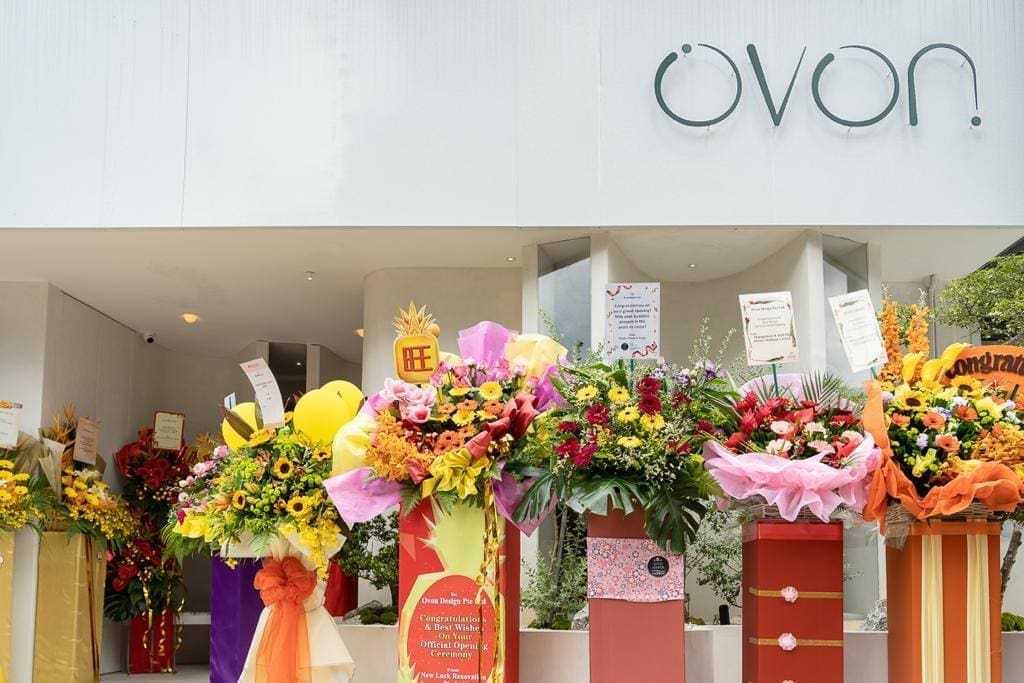
Most of us may have pre-conceived notions of what a shophouse looks like. I’m sure you had a mental image of a shopfront when the word was first mentioned at the start. However, as you can see, the designers at Ovon Design are getting rid of any stereotypes you might have by creating a completely different look. This was done in hopes of creating more awareness for simple landscaping.
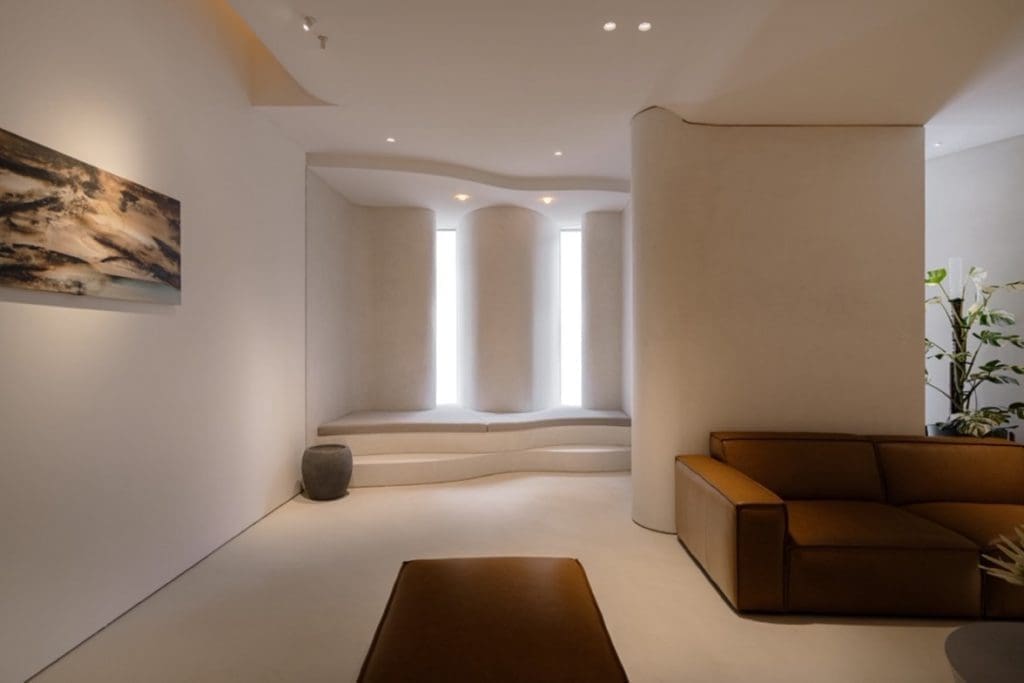
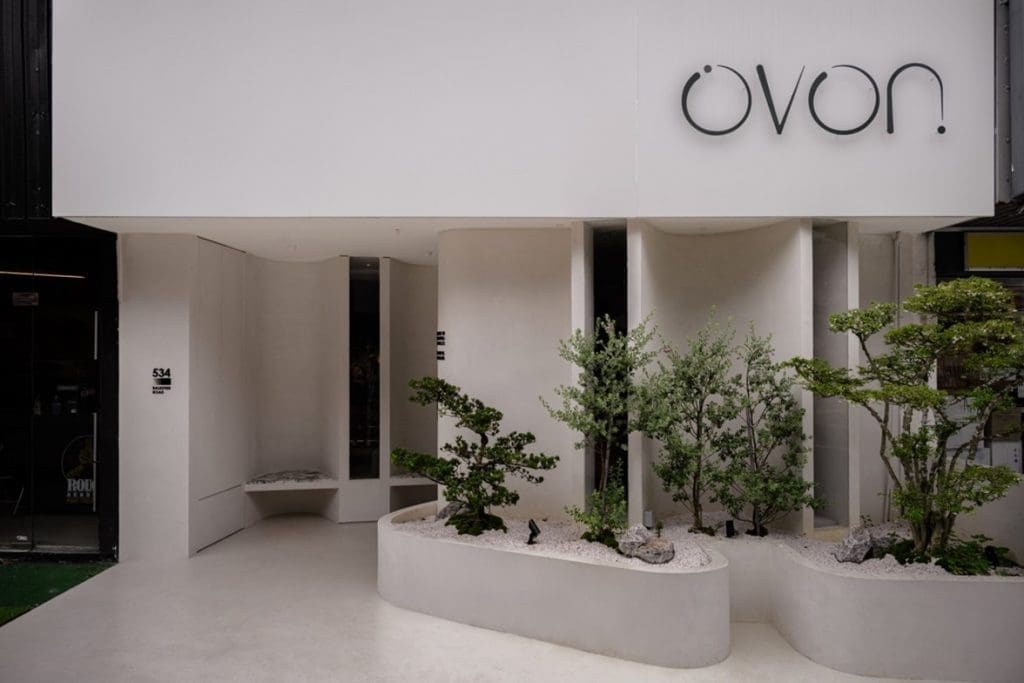

The biggest limitation of single-storey shophouses is the limited space but the designers easily circumvented this issue by introducing a skylight on the roof. This skylight was strategically placed over a tree positioned on their customised table. With a minimalistic concept in mind, they managed to bring about a fascinating contrast using natural varieties of marble and table top surfaces.
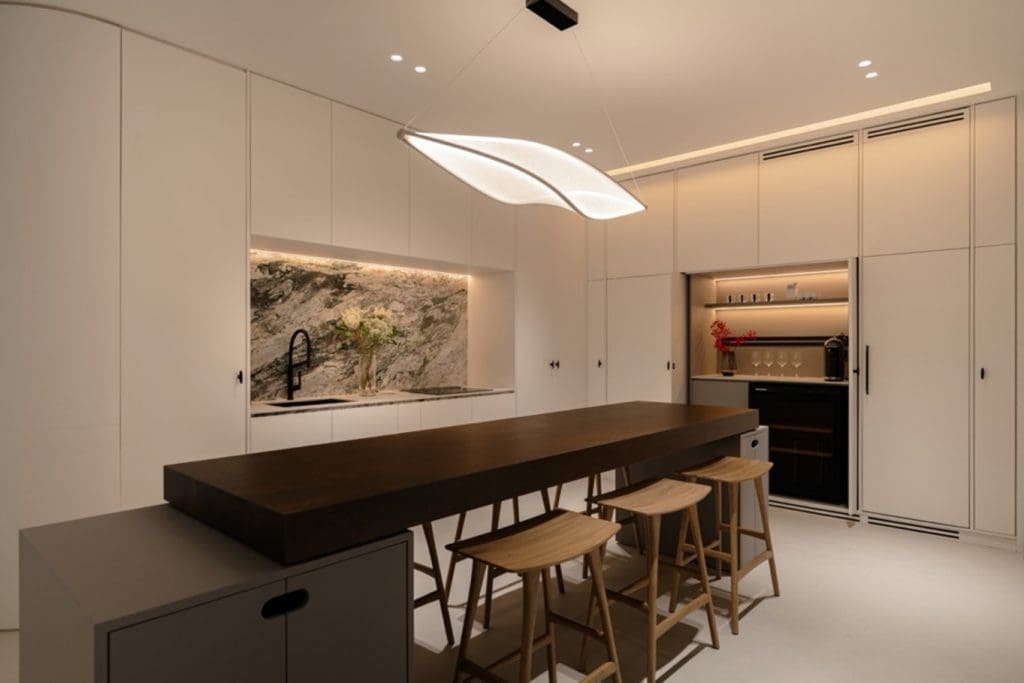
The main goal of this showroom, and Ovon Design in general, is to allow homeowners to feel more connected with a cosy and welcoming space.

On a more practical note, the designers included various co-work spaces that allow the consultants to have a more relaxing environment to converse with clients. These spaces were designed with the intention of boosting creativity and productivity.
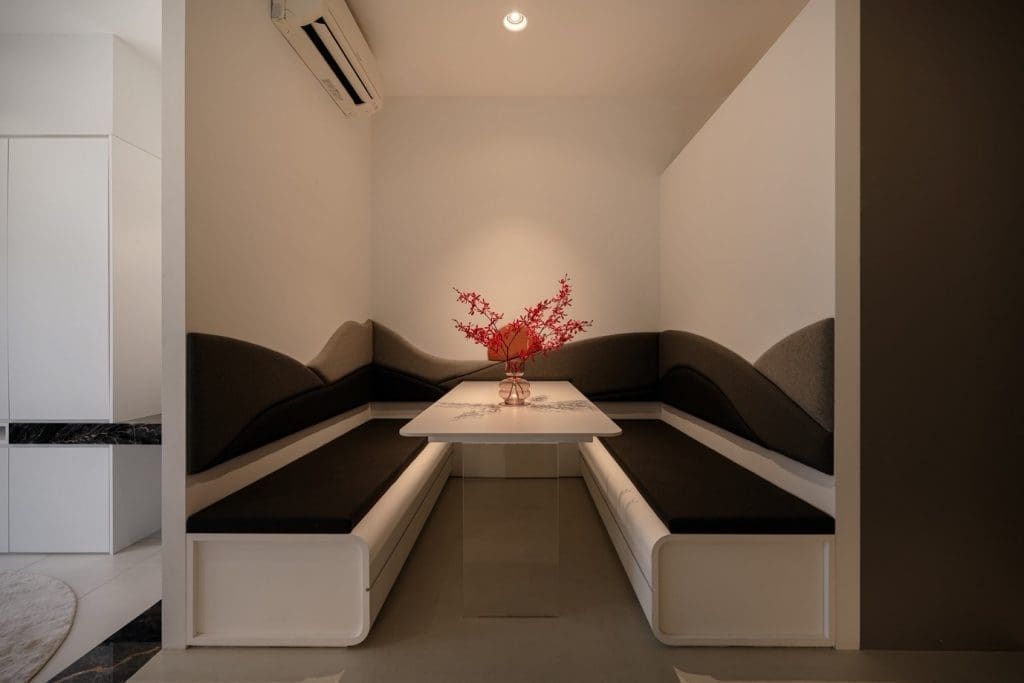
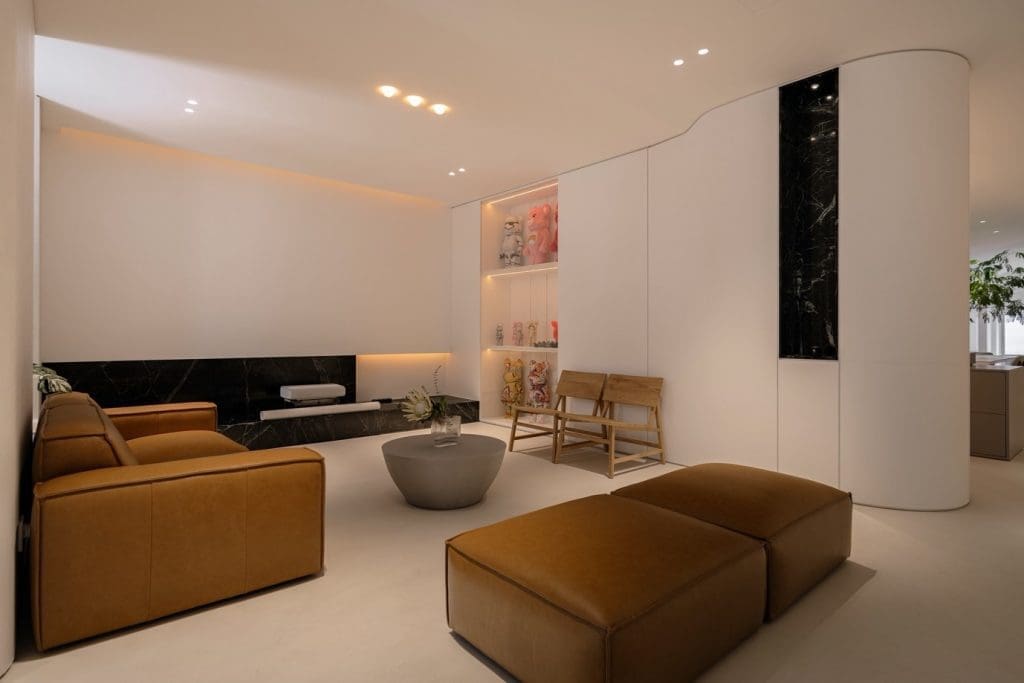
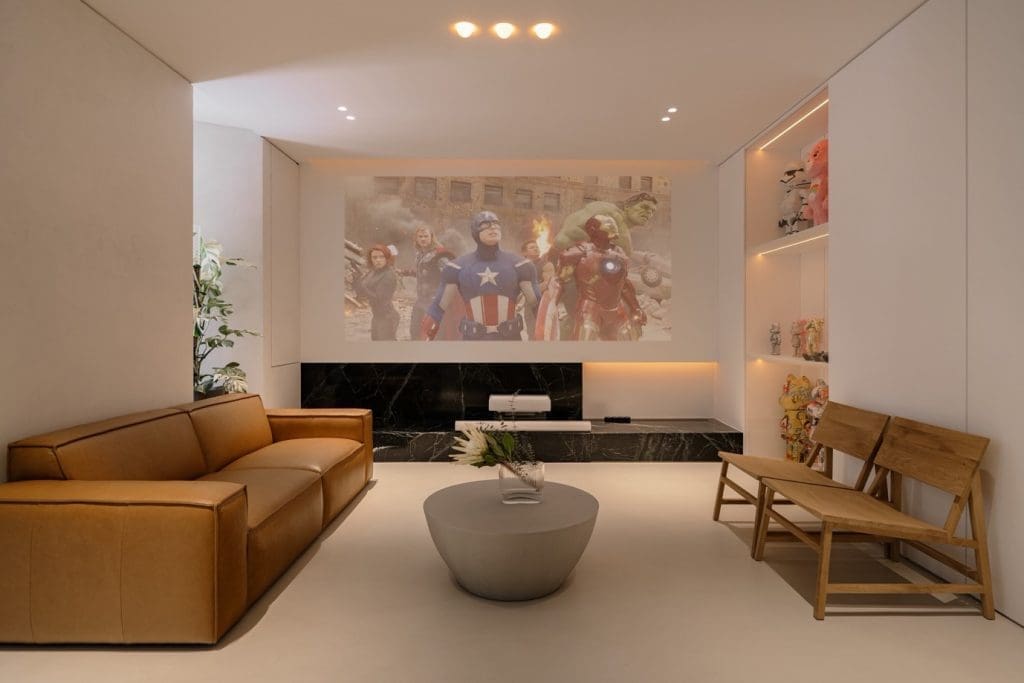


Additionally, Ovon Design places a heavy emphasis on cleanliness and is well aware that clutter can derail meaningful conversations as it is a potent distraction. Hence, the showroom has an enclosed area where all the relevant materials are kept away from view. This space includes an integrated fridge and wine cellers. The designers keep a variety of drinks in stock as long, exciting conversations can cause one to get a little parched.
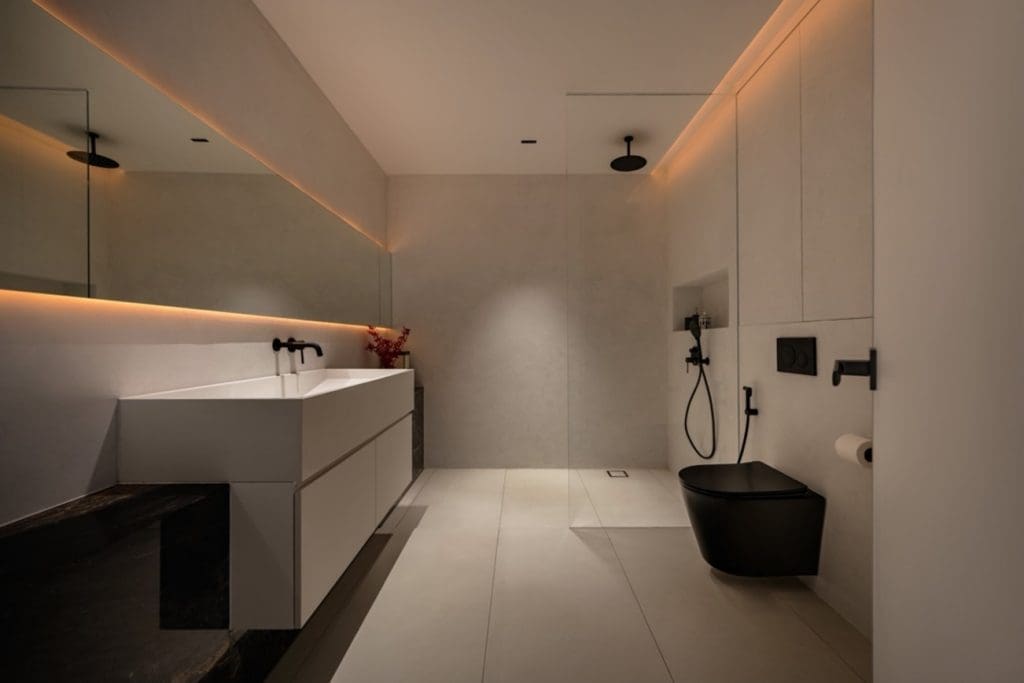
Ovon Design now has a strong 20-man team of experienced designers, including some who are part of the SIDAC (Society of Interior Designers) and RCMA renovation practitioners. Hence, you can rest assured that the consultants know what they are doing and have a creative flair for interior design.
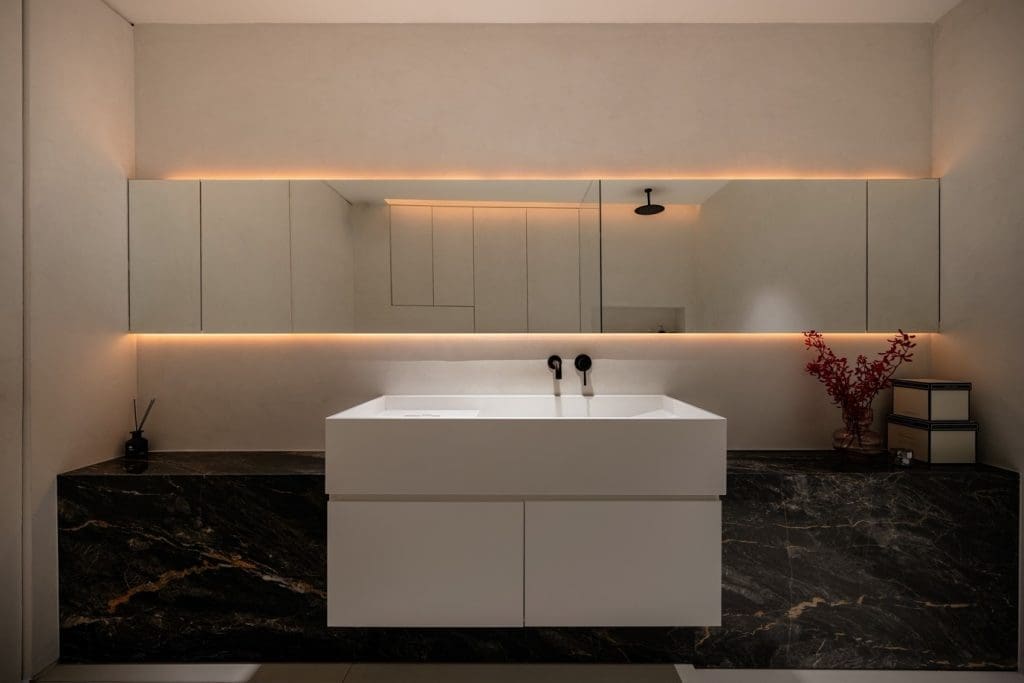
Ovon Design: “ We believe in creating soulful spaces, where beautiful living begins.”
You can have a discussion with one of their qualified consultants at our showroom today, and be one step closer to building your dream home!Ovon Design Showroom 2
534 Balestier Road Singapore 329860+65 8588 2388
enquiry@limegreen-gull-606198.hostingersite.com
Our Joyfully Photos of The Grand Opening






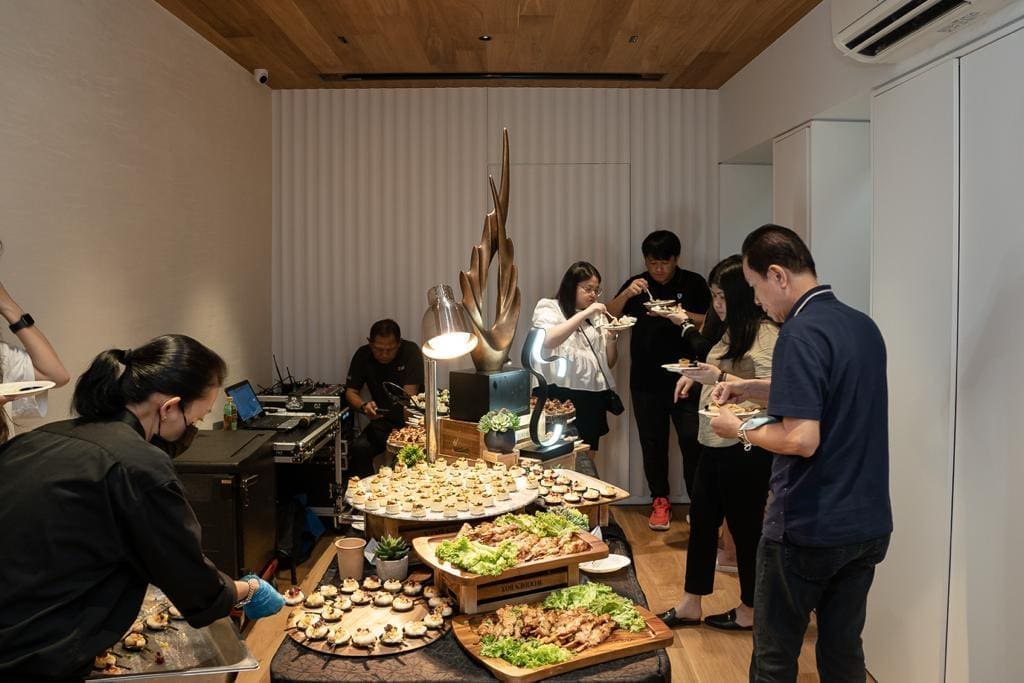

Ovonites


